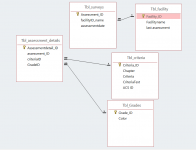I'm developing a database that involves scoring a facility on a list of about 90 different criteria. I have a table that collects a score for each criteria, for each facility, for each date of assessment, and in general my tables and relationships are working well. Now I'm to the point of making data entry easy and what I'd like to create is a form that has a single place to enter "date of assessment", then lists each of the 90 criteria with a place to record the grade. And all of this is aggregated in the table so that queries and reports can be developed.
In my current table arrangement I have it set to record date of assessment and grade separately for each criteria which means inputting the same date 90 times. Is there a better way to organize data entry in a form? Can I apply one date to multiple criteria somehow?
This is not a regularly scheduled assessment and the intervals are not the same for all facilities.
I look forward to your thoughts.
Stephen
In my current table arrangement I have it set to record date of assessment and grade separately for each criteria which means inputting the same date 90 times. Is there a better way to organize data entry in a form? Can I apply one date to multiple criteria somehow?
This is not a regularly scheduled assessment and the intervals are not the same for all facilities.
I look forward to your thoughts.
Stephen


